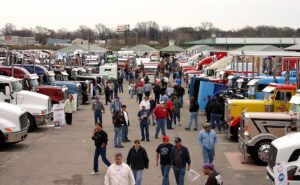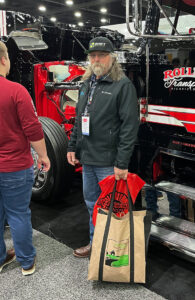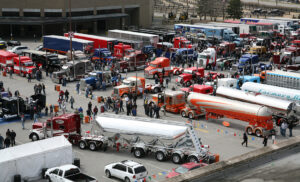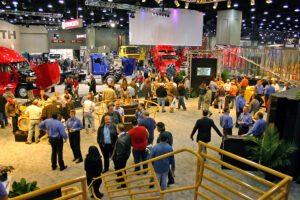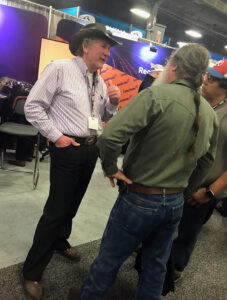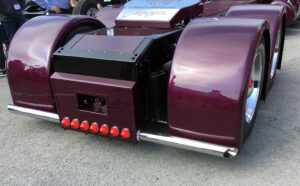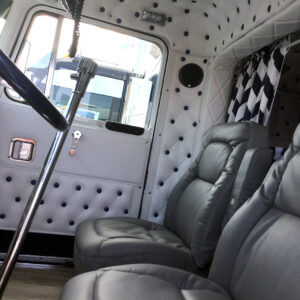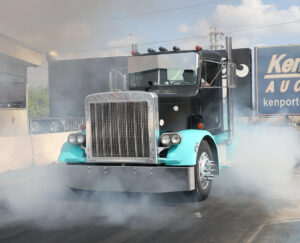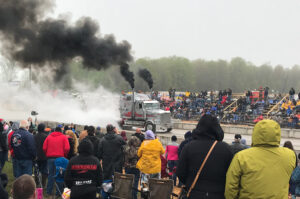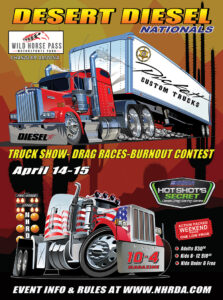Is it March already? It must be, because we have used up all the days in February, and April is just around the corner. And that can only mean one thing – we are counting down the days until MATS (Mid-America Trucking Show) in Louisville, KY. Who said Christmas only comes once a year? MATS is Christmas for truckers, without the greenery and tinsel… ah, hold up there, on second thought, there are plenty of shiny things and colored lights all around, so all you need is one of those pine scented tree shaped air fresheners and there you are, Christmas in spring.
The expo center is stuffed to its limit with all things trucking – everything from a valve stem and air pressure gauge for your tires, to a new set of tires, and maybe even a completely new truck. If your one of the big rollers, you can buy a whole fleet of trucks with matching trailers, all it takes is money. People say money makes the world go around, but I’m not so sure. My vote is for trucks and the drivers who pilot them – they are the reason the world goes around. Without them everything stops: no food, no gas, no nothing! So, let’s hear it for all the dedication to details, the safe operation of equipment, and of course the sacrifice of those who make the wheels turn. I’m talking about you, our valuable and faithful readers.
If you have never experienced all things trucking, then now is the time to saddle up, pack up, and move out with the rest of us heading that way. While you are roaming the halls at the show, don’t forget to stop by the 10-4 Magazine booth (#11268 in the North Wing) and meet and talk to the people responsible for producing the magazine every month. Then, don’t forget to take a selfie of you with the “Team 10-4” folks and post it on their social media pages.
You can never be sure who you may see in the booth or out walking the grounds. Should you run into a big guy with a video camera and lots of other equipment, beware of the microphone he is carrying. That’s J.T. (John Testa), of 10-4 and Studio 10-4 Live, and if you stop and strike up a conversation with him, I guarantee it will be entertaining and informative. Who knows, he might make you famous, but I don’t think you will become rich – at least not at first.
Keep your eyes peeled for more of the crew as most of our contributing writers, editors, and photographers may be lurking around and waiting for the unsuspecting to become the center of their next article or photo shoot. If you do stop by the booth, don’t forget to pick up some swag to wear at your next show, as we will have a brand new shirt design making its debut at MATS. Tell them the old man sent you. It won’t get you any discount, but you might get a free poster, if they aren’t all gone. On your way out from the show, take the opportunity to stop by the show trucks outside in the parking lots, along with all the working treasures parked in the adjoining areas around the expo center. They may not be entered into any competition, but they are certainly worthy of a look.
This is the first show to kick off the 2023 season, so buckle up and hold on. I have been kicking around these shows for many years (probably longer than some new drivers have been alive). In that time, I have seen lots of changes, and the level of competition is much tougher today than it was in the early days. Judging is also more competitive, and it is common to see the top two or three places in a class separated by only a few points. That means to stand out, a competitor has to be special, and that “special” has no limits, except for your imagination (and wallet).
In the last few years, there has been a new trend in truck competitions. It’s not all show and no go, and the amount of chrome, paint, and pinstriping has no play. At these events, wheelbase doesn’t count, but the roar of your engine, the smell of burned diesel, and some blue smoke from slipping your tires, does. In case you are not sure what I’m referring to, its diesel drag racing! The fastest truck wins, and it’s all about the horses and the skill of the driver.
I got the bug a few years ago when a race took place at a small raceway in Michigan called Onaway Speedway. I’m not sure it even had a place on the map at that time, as only the locals knew about it. Since then, we have seen numerous events take place across the U.S., and some are even sanctioned events now in conjunction with the NHRDA (National Hot Rod Diesel Association). The first one this year will be the Desert Diesel Nationals at Wild Horse Pass Motorsport Park in Chandler, AZ on April 14-15.
In case you haven’t guessed, I’m that guy you meet at the truck show who walks past the trailer queens and makes a bee line to the workhorse division. I’m all about power, performance, and pull baby pull! I want to know the specs on the engine, the driveline components, where their torque curve is, stuff like that. I’m always listening to the drivers for tips to squeak out that last little bit of horsepower in a hard pull or the latest secret for performance that will translate to more MPG. But right now, as I am dealing with a major engine overhaul and more, the most important thing for me was what happened (or didn’t happen) as I was on the verge of a catastrophic failure a long way from home.
This month I’m reaching out to the drivers who own and repair their own trucks. I’m a CAT man with a Peterbilt and a long hood, but that doesn’t mean I discount any other brand of engine or the model and style of the cab. I think I have owned or driven about everything out there pre-2010. As a rule, I’m not very impressed with the latest electronic engines or the emission systems that cause them to fail. Each manufacturer produces a product for a given purpose. If you are looking for economy, then Detroit Diesel is the most likely choice. When big power is demanded, and abuse is your game, CAT is my choice. If you need both and want a more refined power plant with a good service record, I would definitely go with Cummins. But no matter your choice, be mindful of how you use it and who repairs it.
In many of my articles over the years, I make references to preparations and the storage of replacement parts. Just last month I lost a week of work because of parts not getting to me in a timely manner. This month I’m taking advantage of my personal parts supply. I’m always planning ahead, and I knew the time would come when my motor would go down. I was hoping it would be a long time from now, but we don’t always get what we want. So, here I am, sourcing parts and planning timeframes around schedules outside of my control. This is where I’m glad I didn’t buy a new pickup last year or a new Harley. Instead, I was collecting parts I would need to rebuild my “Just Steppin” rig.
Did you ever notice the advantage of purchasing parts you know you will need at some point, but are available now, and at a reasonable price? So, what do you do? There are those people who condemn me for spending the money early when I don’t need to, but those same people later complain when they are caught short and in a bind, having to have the parts they need shipped quickly (and costly). When buying parts you don’t need right now, not only can you shop best price, but you can also take advantage of the professional experience of the best builders in the industry. I’m a believer of more information is good, but multiple sources of information is better, and likely to give you a more rounded view of your desired outcome.
This whole project started out as a radiator problem. Many of you know when a radiator fails it is most often not a fault of the radiator, but rather some other part that was pushed to its limit. If you take it to a repair shop, most will replace only what you report the problem to be, looking for the fastest, cheapest, and easiest fix. Remember, they get paid by the hour, not the outcome! I’m not that driver. I will quiz everyone I know as to what can cause such an event. I am always collecting as much information as my brain can absorb. Then, through a process of elimination, find the problem. Then, when making the repair, I take the time to repair or replace any item I find that is substandard, even if it’s not worn out, but only worn in.
Many of my friends say I devote to much time to TLC. Case in point: I had a leaking oil cooler a couple months ago that started this whole thing by blending crankcase oil in the antifreeze. The quick fix was to replace the oil cooler, since I knew it was failing, or at least suspected that was the cause. In the process, I saw the motor mount on the right side had dried up, probably caused by its proximity to the exhaust down tube and the turbo heat. Upon closer inspection, I could see it had wallowed out and was chipping away. Question is, do I fix it now, or leave it until I get a shake, rattle, or roll in the drive line?
For me, an ounce of prevention beats a pound of cure. When you drive a truck that is old enough to vote, you expect things to wear out. As you can guess, when I fixed one thing, it drew attention to other areas that normally you wouldn’t associate with it. Who would have guessed that by changing the oil cooler I would solve my clutch brake problem – two unrelated areas that have a common relation. It turns out the motor mount, when replaced, rotated the clutch arm back to its original position, and upon adjustment, I noticed the eye was worn out, thus throwing my clutch adjustment off. A quick five dollar fix that feels like a million bucks!
While I was replacing the motor mount, I could see I had an oil pan gasket seeping, thus making an oily mess I had to work in. Replacing the pan gasket is not rocket science, but it gave me the chance to look at the lower end of the motor. Since I have a fair number of miles on the truck and the last rebuild was a long time ago, I wanted my engine guy to look up in the bottom end to see what condition my cylinders were in. The report was not as favorable as I had hoped. The prognosis was to prepare for a rebuild sometime soon. Now, skip forward 30 days, and I’m still having pressure issues with my cooling system. Nothing I could point to as the failure, but definitely something wasn’t right.
True to trucking, if anything is going to break, it will when you least expect it or want it to. I was in the middle of South Dakota, well into the night, when the heater stopped working. Within just a couple minutes, I could smell antifreeze. Did I mention the outside temperature was in the lower single digits and there was a 20+ mph wind that night? I don’t remember what the wind chill temp was, but I do remember it was cold. Normally, when something like this happens, it indicates a head related issue, most likely a gasket failure. But it can be a cracked head or injector issue, too. I was nursing it to the next fuel stop when the heater hose burst, leaving me dead on the side of the road.
I must admit this was the first time in all my years of driving I was happy to see the South Dakota State Police light me up and pull in behind me. Thank you, Trooper Jason, for your assistance. I was five miles from the closest place to park. After diagnosing my trouble, he took me there and back to get enough supplies to make a temporary road repair. That is one time when I was blessed to have the support of that thin blue line. It wasn’t enough he helped me get supplies to fix the truck, but he stood out in the wind and held the light, while handing me bottles of antifreeze and water. After all that, he then followed me to a safe haven. I’m thinking he may have been my guardian angel, once again, saving me from myself.
It was a cold night with no heat, but by the time the sun rose in the morning, I had made some phone calls to redirect my load and get a recovery truck headed in my direction. Some of you might wonder why I didn’t run to the nearest repair shop and drop it off. The answer is simple: that truck is my lifeline. It works when I do, it goes where I go, and I depend on it to do what I do. It is worth its weight in gold, and twice as valuable. That means only the best is good enough. No secondhand parts or workmanship. I will gamble a total meltdown before I’ll cut corners, even if it means a pricey tow bill from out of state. If you understand the workings of your equipment and its limitations, you can make decisions that will aid in its recovery. After collecting opinions from other operators and truck builders, I limped home 1,200 miles with a sick engine. I can’t stress enough on how important outside advice is when you are the one under pressure. It’s just as easy to make bad choices as it is to make good ones.
Once my trailer was transferred to another truck, thanks again to Brian Holmberg, who dropped his Alaska load in Minnesota then made my turn to Washington state, before continuing on his way. Sometimes the best parts of the repair are the people who step up and help you. Quality parts or quality people, they are all worth their price, and it doesn’t matter what the cost! I’m still not back on the road yet, but my ride is a lot closer to healthy. At a later time, I will take our readers through the steps of rebuild and refurbishment of an older truck. But for now, I am thankful for the input and advice I have received from those who stepped up and helped me.
Don’t ever think you can’t teach an old dog new tricks, just don’t tell him he is an old dog! As for the tricks, the more a person understands about the functions of their machines, the better they can diagnose, treat, and repair it. Without much effort, a driver can throw fists full of dollars at a problem and never get it right. If they are lucky, and with the help of a few knowledgeable friends, they can turn a bucket of rust and broken parts into something usable again. And just because something is old, that doesn’t mean it’s not good as gold, and twice as valuable. As for now, I’m off on another parts run… with an ultimate destination set for Louisville, KY, 10-4!

